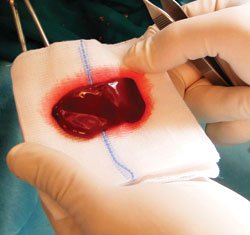Bone marrow and collagen matrix may successfully treat large knee lesions
SAN DIEGO — Autologous bone marrow and collagen matrix, when used as one-step procedure for patients with full-thickness knee cartilage lesions, demonstrated significant improvements on many outcome measures, according to an Italian investigator.
Alberto W. Gobbi, MD, of Milan, presented his team’s findings at the 2011 Annual Meeting of the Arthroscopy Association of North America.
“This is a one-step procedure for cartilage transplantation,” Gobbi said. “It is a user-friendly technique. It has a low cost, if you compare it with standard [autologous chondrocyte implantation] procedures. Of course, we need more prospective randomized studies.”
The purpose of his presented study was to determine how effective the treatment would be when assessed with a variety of scoring scales.
|
|
Different measures
Gobbi and his group prospectively studied 25 patient s who underwent treatment for grade IV cartilage lesions of the knee. Each patient underwent mini arthrotomy and concomitant transplantation of bone marrow aspirate concentrate covered with a collagen matrix.
Gobbi noted that co-existing pathologies received treatment either before or during the surgery, and each patient followed a specific rehabilitation program for at least 6 months. Ten patients displayed multiple chondral lesions.
“These patients had big defects,” Gobbi said. “[The] average size was 8.3 cm².”
|
Image: Gobbi AW |
The team collected X-rays and MRIs preoperatively, at 1 year and at final follow-up. In addition, the investigators assessed patients using the Knee injury and Osteoarthritis Outcome Score (KOOS), visual analogue scale (VAS), International Knee Documentation Committee (IKDC), Lysholm, Marx, SF-36 and Tegner scores. The patients had an average follow-up of 2 years.
The Wilcoxon rank test was used to compare the scores, and Gobbi added that six patients consented to a second-look arthroscopy. Five patients consented to a concomitant biopsy.
Significant improvement
Gobbi reported his team found significant improvement in all measured parameters at the final follow-up. Preoperative to final follow-up improvements included 5.2 to 0.7 on the VAS, 43.6 to 80.7 on the IKDC subjective scale, 60.4 to 92.9 on the Lysholm, 4.2 to 10.3 on the Marx and 2.0 to 4.9 on the Tegner.
MRI results, Gobbi added, displayed strong coverage of the lesions as well as satisfactory tissue quality. There were no adverse reactions or postoperative complications.
“Finally, we wanted to compare single vs. multiple lesions, and we found that patients with a single lesion showed a better improvement than patients with multiple lesions,” Gobbi said. “We also compared smaller vs. larger lesions, and patients with a smaller lesion size showed better improvement than patients with a larger lesion size.” — by Robert Press
Reference:
- Gobbi AW, Karnatzikos G, Mahajan V. The use of bone marrow aspirate concentrated for full-thickness knee cartilage lesions in a one-step procedure: A prospective study. Paper #SS-25. Presented at the 2011 Annual Meeting of the Arthroscopy Association of North America. April 14-16. San Diego.

- Alberto W. Gobbi, MD, can be reached at Orthopaedic Arthroscopic Surgery International (OASI) Bioresearch Foundation, 24 Via Amadeo GA, Milan 20133, Italy; email: gobbi@cartilagedoctor.it.
- Disclosure: Gobbi and co-authors have no relevent financial disclosures.
Gobbi’s paper on bone marrow aspiration certainly is a very attractive procedure — one step, using the patient’s own bone marrow aspirate. One thing I would caution the readers with is that it is not yet clear to me whether or not this is FDA-approved. Before you go out and do that, I would make sure you look into it.
— Peter R. Kurzweil, MD
Session Moderator
Disclosure: He is a member of the speakers bureau for Covidien, an
unpaid consultant for Pierce Surgical Corporation, a stockholder in Orteg, a
member of the editorial or governing board for Sport Medicine and
Arthroscopy Review and Orthopedics Today, and a board member
of the Arthroscopy Association of North America.


